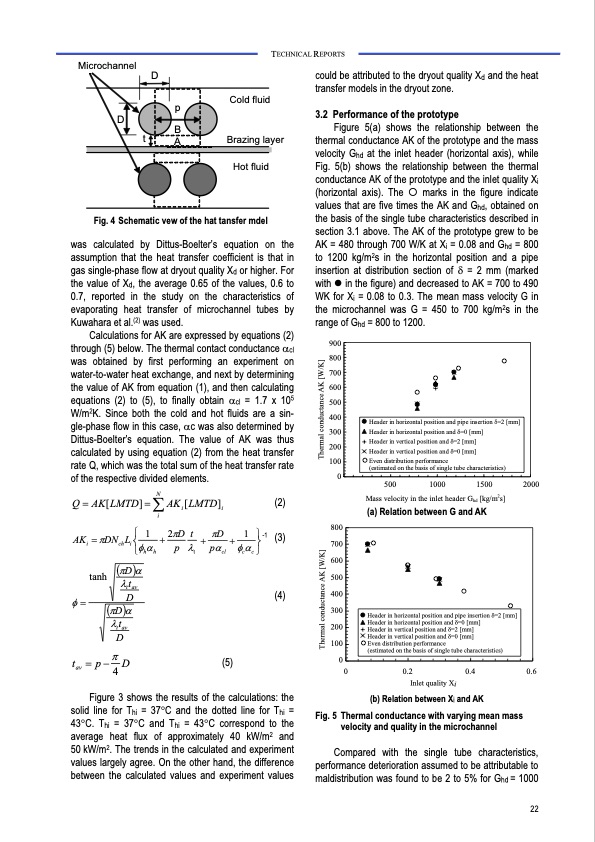
PDF Publication Title:
Text from PDF Page: 024
TECHNICAL REPORTS Microchannel D could be attributed to the dryout quality Xd and the heat transfer models in the dryout zone. 3.2 Performance of the prototype Figure 5(a) shows the relationship between the thermal conductance AK of the prototype and the mass velocity Ghd at the inlet header (horizontal axis), while Fig. 5(b) shows the relationship between the thermal conductance AK of the prototype and the inlet quality Xi (horizontal axis). The�marks in the figure indicate values that are five times the AK and Ghd, obtained on the basis of the single tube characteristics described in section 3.1 above. The AK of the prototype grew to be AK=480through700W/KatXi =0.08andGhd =800 to 1200 kg/m2s in the horizontal position and a pipe insertion at distribution section of δ = 2 mm (marked with � in the figure) and decreased to AK = 700 to 490 WK for Xi = 0.08 to 0.3. The mean mass velocity G in the microchannel was G = 450 to 700 kg/m2s in the range of Ghd = 800 to 1200. Header in horizontal position and pipe insertion δ=2 [mm] Header in horizontal position and δ=0 [mm] Header in vertical position and δ=2 [mm] Header in vertical position and δ=0 [mm] Even distribution performance (estimated on the basis of single tube characteristics) 500 1000 1500 2000 D Cold fluid Brazing layer Hot fluid t was calculated by Dittus-Boelter’s equation on the assumption that the heat transfer coefficient is that in gas single-phase flow at dryout quality Xd or higher. For the value of Xd, the average 0.65 of the values, 0.6 to 0.7, reported in the study on the characteristics of evaporating heat transfer of microchannel tubes by Kuwahara et al.(2) was used. Calculations for AK are expressed by equations (2) through (5) below. The thermal contact conductance αcl was obtained by first performing an experiment on water-to-water heat exchange, and next by determining the value of AK from equation (1), and then calculating equations (2) to (5), to finally obtain αcl = 1.7 x 105 W/m2K. Since both the cold and hot fluids are a sin- gle-phase flow in this case, αc was also determined by Dittus-Boelter’s equation. The value of AK was thus calculated by using equation (2) from the heat transfer rate Q, which was the total sum of the heat transfer rate of the respective divided elements. N2 Q = AK[LMTD] = ∑ AK [LMTD] ii i (2) Mass velocity in the inlet header Ghd [kg/m s] (a) Relation between G and AK Header in horizontal position and pipe insertion δ=2 [mm] Header in horizontal position and δ=0 [mm] Header in vertical position and δ=2 [mm] Header in vertical position and δ=0 [mm] Even distribution performance (estimated on the basis of single tube characteristics) 0.2 0.4 Inlet quality Xi (b) Relation between Xi and AK AK =πDN L⎧ 1 +2πD t + πD + 1 ⎫-1 (3) 800 chi⎨φα pλpαφα⎬ 700 ⎩hh tclcc⎭ i tav =p−π4D 600 500 (4) 400 300 p B A Fig. 4 Schematic vew of the hat tansfer mdel 900 800 700 600 500 400 300 200 100 0 φ= (π D )α tanh λt t av D (π D )α λttav D (5) 200 100 0 0 0.6 Figure 3 shows the results of the calculations: the solid line for Thi = 37°C and the dotted line for Thi = 43°C. Thi = 37°C and Thi = 43°C correspond to the average heat flux of approximately 40 kW/m2 and 50 kW/m2. The trends in the calculated and experiment values largely agree. On the other hand, the difference between the calculated values and experiment values Fig. 5 Thermal conductance with varying mean mass velocity and quality in the microchannel Compared with the single tube characteristics, performance deterioration assumed to be attributable to maldistribution was found to be 2 to 5% for Ghd = 1000 22 Thermal conductance AK [W/K] Thermal conductance AK [W/K]PDF Image | Heat Pump with Natural Refrigerants 3041

PDF Search Title:
Heat Pump with Natural Refrigerants 3041Original File Name Searched:
vol120.pdfDIY PDF Search: Google It | Yahoo | Bing
CO2 Organic Rankine Cycle Experimenter Platform The supercritical CO2 phase change system is both a heat pump and organic rankine cycle which can be used for those purposes and as a supercritical extractor for advanced subcritical and supercritical extraction technology. Uses include producing nanoparticles, precious metal CO2 extraction, lithium battery recycling, and other applications... More Info
Heat Pumps CO2 ORC Heat Pump System Platform More Info
| CONTACT TEL: 608-238-6001 Email: greg@infinityturbine.com | RSS | AMP |